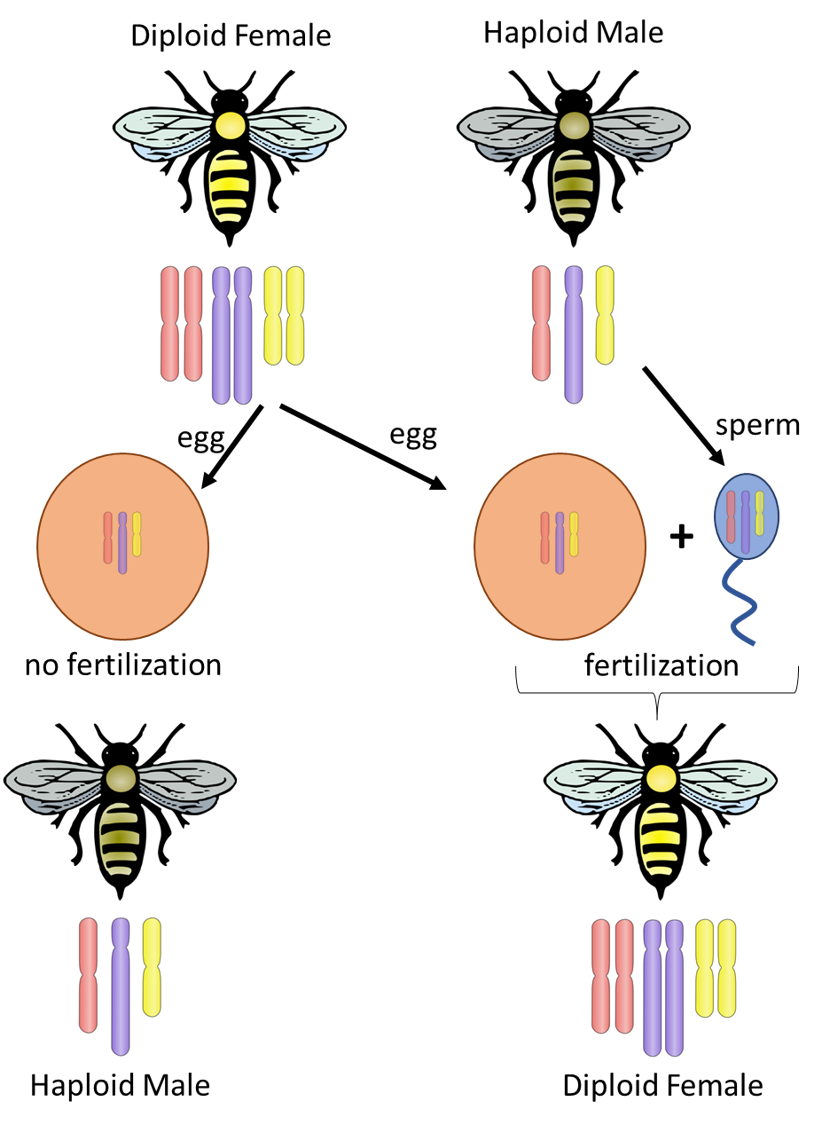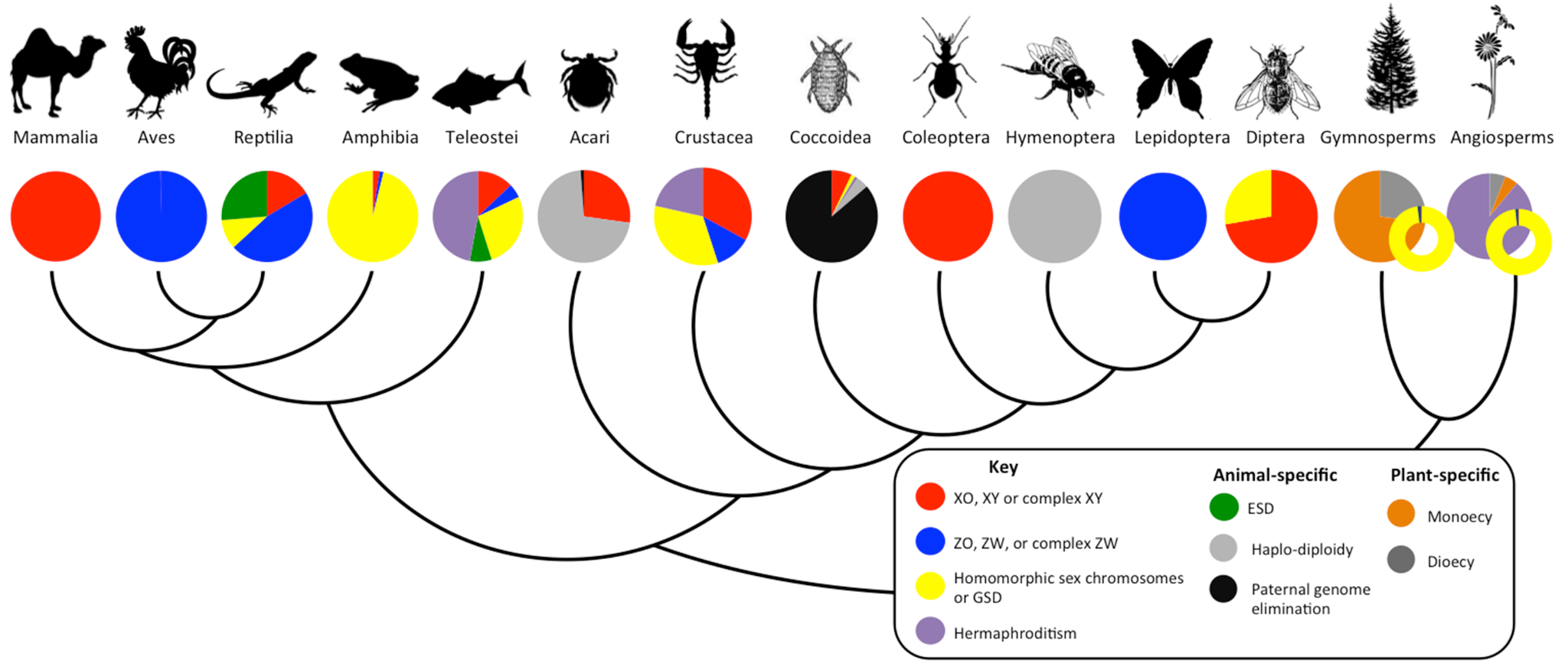8.5 Mechanisms of Sex Determination
What determines whether an embryo develops into a male or female? That depends on the organism. Sex determination is a system that determines the development of sexual characteristics in an organism. For many organisms the answer lies in the organism’s DNA. For others it depends on environmental cues, and for some there is an interaction between environmental cues and genetic information.
Environmental Sex Determination
The sex of some animals is determined by environmental factors, a non-genetic cue. For example, the sex of many species of turtle, alligators, and some fish is determined by the temperature at which the eggs are incubated.


Other environmental cues could be availability of nutrients, light intensity, and presence of pheromones. In the green spoon worm (Bonellia viridis) sex is determined by social influences in the environment. Larvae will become female if they land alone on the seafloor, but if larvae are in physical contact with a female they will become male. This is due to the presence of a chemical, bonellin, which is secreted by females.
Another environmental factor that can influence sex is the presence or absence of particular parasites. Wolbachia are a group of bacteria that live symbiotically in the cells of invertebrates like insects, spiders, and crustaceans. These bacteria have been shown to change genetically male insects into functional (egg-producing) females.
Explore More
Chromosomal Sex Determination
In humans, other mammals, and many animal species, sex is determined by the chromosomes. You may already be thinking about X and Y chromosomes; we will discuss those more shortly. But you should know that many species that use chromosomal sex determination do not have X and Y chromosomes.
Haplodiploidy
In about 12% of all animal species, sex determination involves the entire genome. Males develop from unfertilized eggs, which means they only have one copy of every chromosome (they are haploid). Females develop from fertilized eggs and therefore have two copies of every chromosome (they are diploid). This form of chromosomal sex determination is called haplodiploidy and is found in ants, wasps, and bees. Notice, no X or Y sex chromosomes are present in these species!

Check Yourself
Sex Chromosomes – X and Y
Mammals have sex chromosomes–X and Y. On the mammalian Y chromosome there is a gene called SRY. When SRY is expressed, the resulting protein triggers a series of events often resulting in an embryo developing into a male, with male reproductive physiology and male secondary (non-reproductive) sex characteristics.
An embryo that has two X chromosomes does not have an SRY gene, because it does not have a Y chromosome. An XX individual will usually differentiate into a female.


Sex Chromosomes – Z and W
In birds and some reptiles, the individual with two different sex chromosomes (called ZW) are female, while those with two copies of the same sex chromosome (ZZ) are male. Again, no X or Y sex chromosomes here either! Additionally, in species with this sex determination system, it is the female that has two different sex chromosomes and the male that has two of the same sex chromosomes.

Hermaphroditism
We will discuss this in more depth later, but briefly hermaphroditic species have individuals that produce both male and female gametes. Some species like earthworms and banana slugs produce both gametes simultaneously. Other species develop first as one sex and later change to a different sex – depending on developmental or environmental cues.Clownfish are an example of this ability to change, called sequential hermaphroditism. Clownfish live in small groups with a breeding male and female and up to four non-breeding males. The female is the largest and the dominant fish in the group. If the female leaves the group (often by dying), the breeding male will differentiate into a female and one of the previously non-breeding males will become the new breeding male.

Sex Determination: So many ways of doing it
The image below is a phylogenetic tree showing sex determination mechanisms across various classes of organisms. X0, XY, Z0 and ZW indicate chromosomal sex determination. GSD stands for genetic sex determination. ESD is environmental sex determination. Haplo-diploidy means that males are haploid (have only one copy of genetic information; resulting from an unfertilized egg) and females are diploid (have two copies of genetic information; resulting from a fertilized egg).

Check Yourself
- Image "Leatherback Turtle eggs hatching at Eagle Beach, Aruba" by Elise Peterson. Shared with CC-BY 3.0 license. ↵
- Image by Sylvain Ledoyen. Shared with CC-BY-SA 3.0 license. ↵
- Image by Katherine Furniss using images "Abeille-bee" by Emmanuel Boutet and "Haploid vs diploid" by Ehamberg, shared with CC-BY-SA 2.5 and CC-BY-SA 3.0 licenses, respectively. ↵
- Image "SRY gene location" by the NIH. Public domain. ↵
- Image of Nettie Stevens, in the public domain. ↵
- Image modified (cropped) from "Some chromosomal sex determination systems in animals" by CFCF. Shared with CC-BY-SA 3.0 license. ↵
- Image "Clownfish-Houston-Zoo" by Karamesh. Shared with CC-BY 3.0 license. ↵
- Image "Diversity of sex determination systems for representative plant and animal clades" by Doris Bachtrog et al. Published with CC-BY 4.0 license. Find full article at https://doi.org/10.1371/journal.pbio.1001899 ↵

